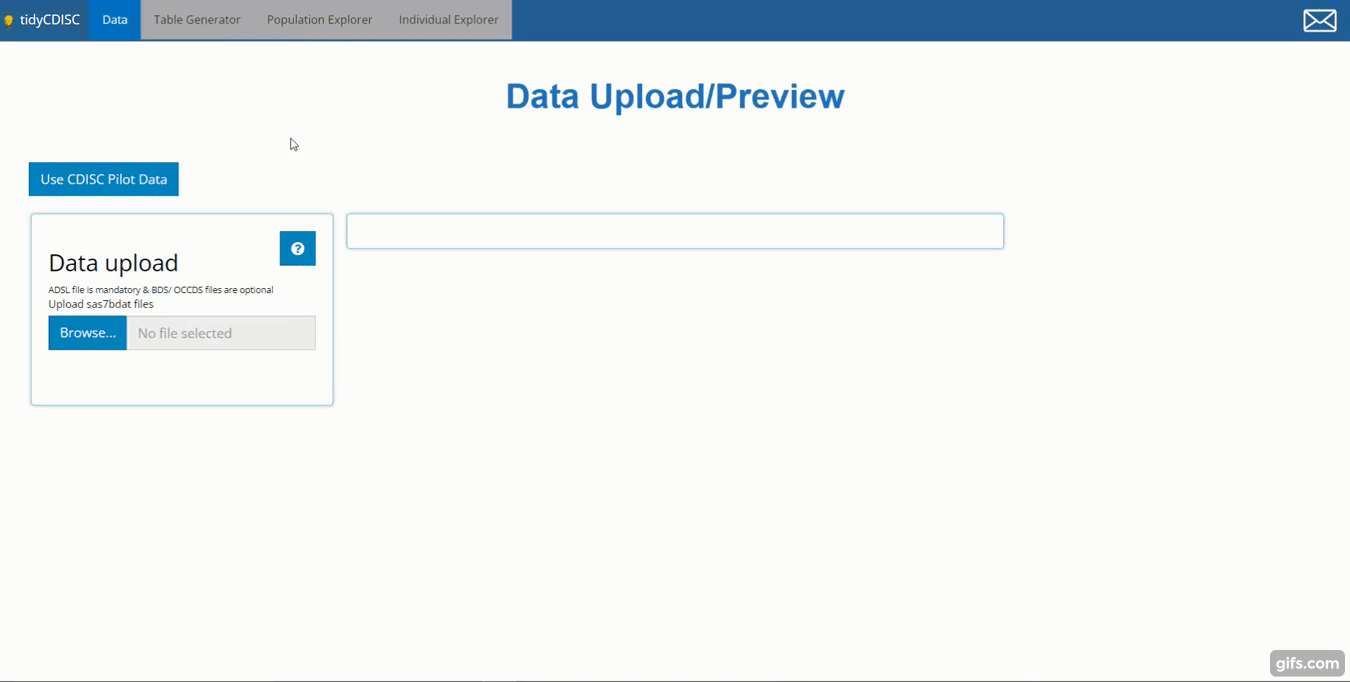Rightfully so, the Data tab is the initial landing
page for the tidyCDISC app. It’s a place where you can
find, upload, and view your data before proceeding to the analysis tabs,
which are disabled until a ADSL sas7bdat file is
uploaded.
Upload requirements
This application was designed for quick analysis of ADaM-ish data, so
since preparing sas7bdat files are apart of that process,
tidyCDISC only accepts SAS data sets for upload. Thus,
inside the window titled “Data Upload”, you’ll notice the following
text: “ADSL file is mandatory and BDS/ OCCDS files are
optional. Upload sas7bdat files.”
With an ADSL alone, you can explore all the tabs of this
application, although, uploading more data with other data types is
encouraged for optimized exploration. The tidyCDISC
application was designed to analyze ADaM data of the following types,
each having a unique purpose in the application:
-
ADSL: demographic and trial info - one row per subject -
BDS: or “basic data structure” contains variables such asPARAMCD,AVAL, andAVISITor some other visit variable that reports on metric values over time for each patient. -
OCCDS: Occurrence style data, reporting on adverse events, con-meds, or medical history, for example. -
TTE: Time-to-event data, identified by the presence of the requiredCNSRvariable.
Identifying these data types, the app includes precise upload rules for each, accessible via the small button with a question mark:
Upon clicking, what we define as “ADaM-ish” upload rules will pop up
in a new window. There are several sets of rules. Some rules are
“Required” and others are “Recommended”. In general,
“required” rules are absolutely foundational to the app’s function.
Conversely, “recommended” rules are only suggestions to get the most
feature-rich experience in the app. More on this later, but first, and
quite plainly, our first and most pervasive rule is that all uploaded
data must contain a USUBJID variable. Without this field,
data portrayed in one data set simply cannot be linked to data in
another, so this is a foundational rule and one that CDISC also
imposes.
As depicted above, there exist different rule sets for specific data
sets. Here, you can interpret the first rule as follows: “If you upload
an ADMH, it’s required that it contains a variable
called MHCAT.” This is so that core features in the app
will work appropriately. Directly beneath, read the next rule as: “if
you upload an ADAE, it’s recommended that it have
variables AESTDT, AEDECOD, AESEV,
and AESER be present.” Even though some of those variables
may be required according to CDISC, they are only recommended here,
hence the label “ADaM-ish”. In the absence of the recommended variables,
some features of the app may be voided, but the app will still function
just fine without them.
The final two sets of upload rules exist to make sure certain that
data sets containing certain variables are treated appropriately. First
if the data contains CNSR (i.e. TTE type
data), it should also contain PARAMCD and
AVAL. And finally, rules that apply to non-TTE
type data: if the data contains PARAMCD (BDS
data) it must also contain AVISITN, AVISIT,
PARAM, AVAL, CHG, and
BASE.
If any of these rules are violated, a prompt error or warning message
will appear when attempting to upload the faulty data. If the uploaded
data is missing a required variable (or if the variable exists, but is
populated will only missing values), an error will be issued and your
data will not upload to the application. If a recommended variable is
missing, a warning is issued but the data source can still be used
within the application. Here is an example of an attempt to upload an
erroneous data set, an ADARR, with a litany of problems.
Notice how the app checks that the variable both (1) exists and (2) is
non-missing below. A red X indicates the area(s) that need
attention and led to the failed test.
If you are having trouble uploading your data, and you think you have significant grounds to alter these upload rules, please contact us with your request.
Use CDISC Pilot Data
Press this button if you are not interested in using
tidyCDISC with your study data yet, but want to explore all
the app’s features. Upon clicking, you’ll see five data sets are loaded:
an ADSL, ADVS, ADAE,
ADLBC, and ADTTE. All these data sources came
from the PHUSE Test
Data Factory’s public GitHub. Note that some adjustments were made
to the raw data in order to best suit the needs of the application. That
is, in some cases, variables were created and imputed with values that
were applicable for the trial. For the sake of data security, we’ll use
this data thoroughly throughout this guide.
Browse
When not using the CDISC pilot data, select “Browse” to navigate
through your computer’s file system and locate your study’s data. If you
normally do not have permissions to a certain folder,
you will still not have permission to that folder while
using tidyCDISC. You may select one file at a time or
multiple files at once. Just note (as mentioned previously) that an
ADSL is required for any analysis, so make sure one is
loaded from your study. Since the application is designed for ADaM-ish
data, only sas7bdat files are accepted.
Once selected, the file names will show up below the browse widget and populate the data preview window.
Data Preview
The data preview exists to give users a perfunctory view of their data to make sure it uploaded correctly. Thus, the viewing window was intentionally designed to be small and hard to navigate! Just make sure your data is there and intact, then head over to the other tabs to dissect and analyze it.

Specifically, try out the…
Table Generator to quickly and easily create submission compliant tables and listings
Population Explorer to plot trends in your treatment groups over time (among other things)
Individual Explorer to learn more about outlier patients or patients with certain adverse events, etc.